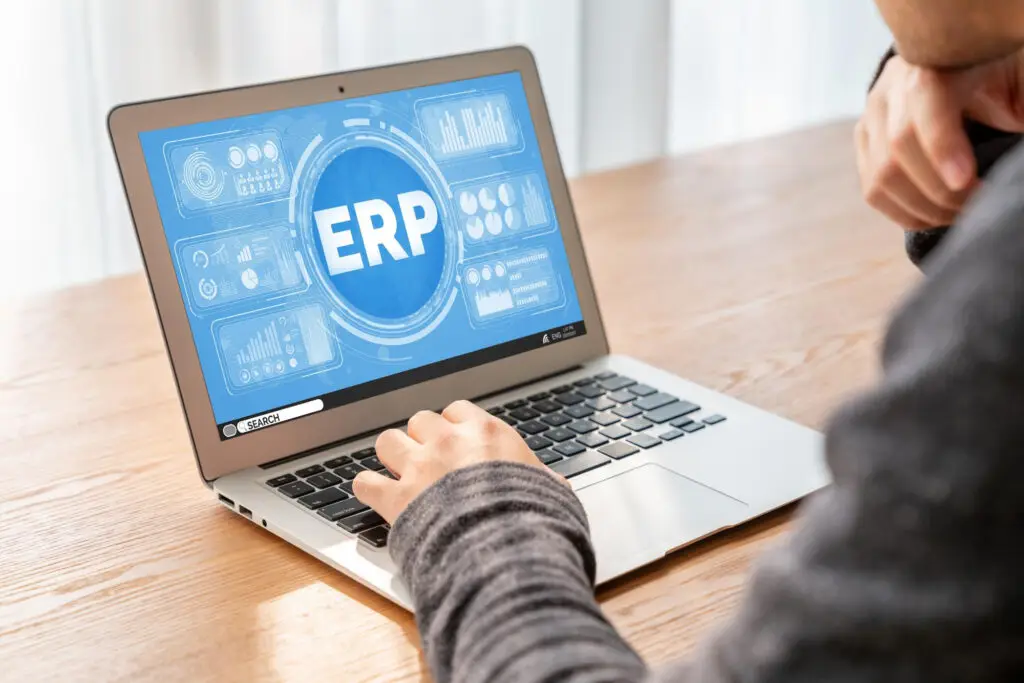In today’s multi-faceted business landscape, the effective administration of Enterprise Resource Planning (ERP) systems is critical for obtaining strategic decision-making and driving operational efficiency. ERP systems incorporate several business functions into one integrated platform, optimizing data flow and processes across an organization. However, these intricate systems need skilled leadership to help manage them and that’s where the role of Chief Information Officer comes into play.
Importance of Enterprise Resource Planning (ERP) Systems in Modern Businesses
Enterprise Resource Planning (ERP) systems serve as the foundation of various modern businesses, delivering comprehensive solutions for overseeing essential business functions like customer relationship management (CRM), finance, supply chain and human resources. These systems consolidate data from various departments into a centralized database, offering real-time insights that support well-informed decision-making.
In today’s competitive market, businesses rely on ERP systems to streamline operations, boost productivity and promote collaboration among departments. The smooth incorporation of business processes-provided by ERP systems-is crucial for sustaining responsiveness and flexibility in fast-paced evolving industries.
Overview of the CIO’s importance in Overseeing ERP Implementations and Management
As technology drives company innovation, the Chief Information Officer (CIO) plays an important role in effectively managing ERP systems. Apart from being a technology expert, the CIO is also a strategic leader who connects IT concepts to overall company goals.
In the world of ERP, the function of the CIO extends beyond technical oversight to include strategic planning, stakeholder collaboration, risk management and innovation. The CIO ensures that ERP systems are not only functional but also beneficial to the organization’s competitiveness and growth.
Understanding ERP Systems
Enterprise Resource Planning (ERP) is important for modern businesses because they provide an all-in-one solution for handling data and core processes. To understand the role of a Chief Information Officer (CIO) in ERP management, it is also vital to understand the basic principles of an ERP system.
Definition and Objectives of ERP Systems
ERP systems are software applications that integrate and automate critical business processes such as customer relationship management (CRM), finance, inventory management, human resources, sales and procurement. The main aim of ERP systems is to boost efficiency, streamline processes and provide a consolidated platform for reporting and data management.
Overview of ERP Components and Functionalities
ERP systems are composed of interlinked modules designed to cater to specific business functions. These modules normally include:
- Human Resources (HR): Supervising payroll, employee information, workforce planning and benefits.
- Finance: Carrying out financial reporting, budgeting and accounting.
- Manufacturing: Managing quality control (QC), production planning and scheduling.
- Supply Chain Management (SCM): Controlling inventory, procurement, order fulfillment and logistics.
- Customer Relationship Management (CRM): Supporting sales, marketing, client interactions and customer data.
ERP systems merge these modules into an organized system, facilitating cross-functional collaboration and enabling data visibility across departments.
Importance of ERP Integration Across Business Processes
One of the primary benefits of ERP systems is their ability to incorporate multiple business processes into a single framework. This reduces redundancies and poor inter department communication with data, enabling companies to improve departmental collaboration and streamline work processes.
ERP systems provide real-time data sharing and analysis by integrating departments such as human resources, supply chain management as well as finance, resulting in operational efficiency and informed decision-making. This interconnection promotes more efficient collaboration, which are critical for driving business growth and adapting to changing market trends. Understanding the integration capabilities and fundamental components of ERP systems is essential for learning the role of the CIO in managing these complex platforms.
Key Responsibilities of the CIO in ERP Management
The Chief Information Officer (CIO) plays a pivotal role in supervising the implementation, enhancement and control of Enterprise Resource Planning (ERP) systems in organizations. Apart from technical proficiency, the duties of the CIO involve strategic planning, business goals alignment and guaranteeing the optimal functionality of ERP solutions.
Strategic Planning and Alignment of ERP with Business Objectives
A key responsibility of the CIO in ERP management is strategic planning. The CIO works with top management and key stakeholders to determine business objectives and understand how ERP systems can reinforce these goals. This includes:
- Developing an ERP roadmap that aligns with the organization’s long-term vision.
- Assessing potential ERP solutions based on scalability and business needs.
- Outlining implementation schedules, milestones and resource distribution.
The CIO’s strategic vision ensures that ERP investments are in sync with broader business strategies, providing concrete value and fostering innovation.
Selection and Implementation of ERP Solutions
The Chief Information Officer (CIO) oversees the selection and deployment of ERP solutions, managing the entire process from evaluating vendors to providing post-implementation support. Key responsibilities include:
- Assessing vendors and choosing the most suitable ERP solution to meet organizational requirements.
- Working with cross-functional teams (operations, IT and finance) to drive successful implementation.
- Handling change management and managing stakeholder expectations throughout implementation.
- Supervising customization, data migration, training processes and testing.
The CIO ensures seamless integration of the selected ERP solution with existing systems and workflows, thereby enhancing operational efficiency and user adoption.
Continuous Monitoring and Optimization of ERP Performance
After implementation, the Chief Information Officer (CIO) is responsible for overseeing and enhancing ERP performance to maintain on-going value and return on investment (ROI). This includes:
- Establishing key performance indicators (KPIs) to gauge ERP effectiveness.
- Monitoring system performance, identifying bottlenecks and promptly resolving issues.
- Collaborating with business units to pinpoint opportunities for process enhancement and streamlining.
- Implementing upgrades, patches, and enhancements to ensure the ERP system remains up-to-date and aligned with changing business demands.
Continuous monitoring and optimization guarantee that ERP systems remain adaptable and responsive to organizational needs, fostering sustained business development.
Ensuring Data Security and Compliance Within the ERP Environment
Data security and compliance are critical in ERP management. The CIO oversees:
- Implementing strong security measures to safeguard critical data in the ERP system.
- Ensure compliance with data protection requirements and industry regulations.
- Regular audits and assessments to detect and reduce security vulnerabilities.
- Educate personnel on data privacy best practices and install access controls.
By focusing on data security and compliance, the CIO protects organizational assets and maintains stakeholder trust in ERP systems. The CIO’s different responsibilities in ERP management go beyond technical oversight, stressing strategic leadership and collaboration throughout the organization.
Collaboration with Stakeholders
Effective collaboration with stakeholders is essential for the successful implementation and management of Enterprise Resource Planning (ERP) systems in organizations. As an important leader in ERP management, the Chief Information Officer (CIO) has a key role in enabling communication and collaboration among functional departments.
Importance of Cross-Functional Collaboration in ERP Management
ERP systems affect several parts of an organization, including finance, operations, human resources and customer service. Collaboration with stakeholders from all departments is critical to ensuring that ERP implementations are consistent with business procedures and needs. The advantages of cross-functional collaboration include:
- Alignment of ERP functionalities with business requirements: Involving stakeholders from various departments helps customize ERP configurations to detailed workflows and requirements, causing streamlined efficiency and user adoption.
- Identification of interdependencies: Cross-functional collaboration enables the recognition of interconnections between business operations, facilitating seamless integration and data exchange among departments.
- User acceptance and change management: Engaging stakeholders early in the process encourages support and cultivates a culture of change readiness, which is vital for the successful adoption of ERP systems.
Role of the CIO in Facilitating Communication Between IT and Business Departments
The Chief Information Officer acts as a link between IT and business departments. They translate technical capabilities into business value and vice versa. Key elements of the CIO’s role in enhancing communication consists of:
- Understanding business requirements: The CIO collaborates closely with business leaders to grasp their challenges, goals and desired outcomes related to ERP systems.
- Simplifying technical complexities: The CIO conveys ERP capabilities and constraints using business-friendly terms, aiding stakeholders in understanding how technology affects their daily operations.
- Managing expectations: The CIO establishes realistic expectations for ERP implementations and schedules, ensuring transparency and accountability throughout the process.
- Handling concerns and feedback: The CIO actively seeks feedback from stakeholders, addressing concerns to optimize ERP solutions and enhance user satisfaction.
Strategies for Fostering Collaboration to Maximize ERP Benefits
To foster successful collaboration and fully capitalize on ERP advantages, CIOs would be wise to thoughtfully craft various strategies such as:
- Forming cross-functional teams: Establishing teams with members from IT, finance, operations, HR as well as other departments enables comprehensive decision-making and fosters a shared vision of ERP goals.
- Holding regular stakeholder meetings and workshops: Engaging stakeholders with consistent meetings and workshops throughout the ERP lifecycle promotes involvement and accountability.
- Offering training and assistance: Investing in training programs and user resources improves user skills and speeds up ERP adoption company-wide.
- Commemorating milestones and successes: Acknowledging accomplishments and celebrating milestones creates a positive ERP environment, emphasizing the importance of collaboration and teamwork.
By prioritizing interactive communication among all involved parties, CIOs can enhance ERP implementations, promote synchronization within the company and unleash the full potential of ERP systems to power business growth and innovation through collaboration.
Driving Innovation and Digital Transformation
Innovation and digital adaption are imperative for businesses striving to maintain their competitiveness and adjust to evolving market conditions. An Enterprise Resource Planning (ERP) infrastructure, directed by the Chief Information Officer (CIO), acts as a catalyst for innovation and helps companies undertake digital transformation initiatives.
Leveraging ERP Systems for Digital Transformation Initiatives
ERP systems are pivotal in digital transformation as they establish a base for unified business processes and data-informed decision-making. The CIO utilizes ERP functionalities to spearhead digital projects like:
- Automation and process enhancement: Integrating workflow automation and smart process management in ERP systems simplifies operations, decreases manual tasks while boosting efficiency.
- Advanced analytics and business intelligence: Employing ERP data for predictive analytics, reporting and visualization empowers proactive decision-making and strategic insights.
- Integration with emerging technologies: Fusing ERP with emerging technologies such as Internet of Things (IoT), artificial intelligence (AI) and machine learning (ML) amplifies operational effectiveness and enables innovative scenarios.
By capitalizing on the abilities of ERP infrastructure, CIOs enable organizations to fully embrace digital change and foster innovation across every facet of their business operations.
Role of the CIO in Driving Innovation Within ERP Environments
As leaders in innovation, CIOs lead transformative efforts within ERP environments. Their primary duties encompass:
- Exploring new technologies: CIOs discover and assess emerging technologies that complement ERP functions and add business value.
- Fostering a culture of experimentation: Encouraging experimental initiatives and pilot programs in ERP settings nurtures a culture of innovation and continual enhancement.
- Collaborating with business executives: By collaborating with business departments, CIOs identify innovation prospects and develop scenarios that utilize ERP capabilities to gain a competitive edge.
- Forging strategic alliances: Creating strategic partnerships with tech vendors and startups grants access to state-of-the-art solutions that improve ERP capabilities and support innovation plans.
Through a proactive strategy for advancing innovation in ERP environments, CIOs not only bolster operational efficiency but also position their organizations for long-term growth and market dominance.
Examples of Businesses Utilizing ERP for Innovation and Competitive Advantage
Many businesses have successfully used ERP systems to foster innovation and gain a competitive advantage:
- Amazon uses advanced analytics and AI in ERP systems to estimate demand, optimize inventory management and customize consumer experiences.
- Procter & Gamble leverages ERP systems for real-time communication with suppliers and distributors, ensuring agility and responsiveness in a dynamic market.
- Tesla optimizes manufacturing processes and supply chain management by integrating ERP and IoT technology, allowing for quick production scalability.
These examples highlight how corporations with visionary CIO leadership use ERP systems as strategic assets for competitive differentiation, innovation and digital transformation.
Managing ERP Risks and Challenges
Enterprise Resource Planning systems promise significant improvements, but their execution and administration also introduce inherent risks and obstacles. The Chief Information Officer (CIO) plays a pivotal part in identifying, alleviating and overcoming these struggles to guarantee the success of ERP initiatives in organizations.
Common Challenges Associated with ERP Implementation and Management
Common obstacles encountered during ERP implementations include:
- Complexity and customization involve modifying ERP systems to align with specific operational processes, leading to increased effort and time spent on implementation.
- Transferring data from older systems while incorporating various sources of information into ERP platforms presents technical and logistical difficulties.
- Resistance to change and low rates of user adoption can impede ERP implementation and hinder operational enhancements. Addressing employee reluctance involves constant communication and training to encourage support.
- Inadequate budget, expertise in addition to internal resources may postpone ERP projects and affect overall success. Careful planning helps ensure appropriate allocation of limited resources.
Strategies for Mitigating Risks and Overcoming Challenges
The CIO utilizes strategic methods to reduce ERP risks and address implementation challenges:
- Thorough planning: Detailed project planning, including assessing needs, gathering requirements as well as involving stakeholders, establishes a solid groundwork for successful ERP deployments.
- Vendor selection and partnership: Working with reputable ERP vendors and maintaining strong vendor relationships ensures access to expertise and assistance throughout the implementation process.
- Training and change management: Proactive change management tactics, combined with comprehensive user training and support, help promote adoption and reduce problems with ERP modifications.
- Optimization and ongoing monitoring: Enforcing governance frameworks while conducting regular evaluations assist in early problem detection and resolution. The help ensures that ERP systems meet changing business requirements.
Role of the CIO in Leading ERP Risk Management Efforts
As a strategic leader, the CIO takes a proactive risk management approach when implementing ERP systems:
- Risk assessment and mitigation: the CIO identifies potential issues associated with new ERPs, crafts contingency plans to mitigate threats and establishes protocols to monitor risks.
- Stakeholder communication: transparently sharing challenges and being open about vulnerabilities fosters collaboration across departments and spreads accountability.
- Performance monitoring and course correction: constant performance tracking and a willingness to change course when targets aren’t met ensures corrections are made and projects are on schedule.
- Learning from failures: Embracing a culture of continuous improvement, the CIO learns from past ERP mistakes and uses insights to improve future installations.
By proactively managing risks, communicating openly with stakeholders, monitoring progress vigilantly as well as learning from mistakes, the thoughtful CIO guides successful ERP deployments that optimize business operations and build organizational resilience for future challenges.
Ensuring Scalability and Flexibility
Scalability and flexibility are important qualities of Enterprise Resource Planning (ERP) systems, allowing companies to adapt to changing business needs and sustain long-term growth. As technology strategy leaders, the Chief Information Officer (CIO) is responsible for ensuring that ERP solutions are scalable, agile and adaptable to changing organizational needs.
Importance of Scalability in ERP Systems to Support Business Growth
Scalability in an ERP system pertains to its capacity to manage increasing data volumes, users, transactions and business intricacy while maintaining performance standards. The CIO underscores scalability to:
- Facilitate business expansion: ERP systems need to seamlessly scale as organizations expand, accommodating additional operations, users and data volumes.
- Simplify mergers and acquisitions: Scalable ERP solutions support the smooth integration of new entities and business units into existing systems, enhancing operational efficiency and fostering collaboration.
- Respond to market dynamics: Scalable ERP systems foster agility and responsiveness, empowering organizations to pivot in alignment with market changes and emerging prospects.
Ensuring scalability is paramount in safeguarding ERP investments for the future and optimizing their enduring value for the organization.
Role of the CIO in Ensuring ERP Flexibility to Adapt to Changing Business Needs
Flexibility is one of the many important features of ERP systems, allowing corporations to modify workflows, functionalities and configurations to meet evolving business needs. The CIO champions ERP flexibility through:
- Implementing modular architectures: Allows organizations to append or modify components as necessary, facilitating agile responses to ever-changing business needs.
- Promoting interoperability: Making sure ERP systems easily incorporate with external applications, platforms and technologies. It also advances flexibility and eases information exchange across ecosystems.
- Embracing cloud-founded options: Cloud-founded ERP solutions provide scalability and flexibility by enabling on-demand resource provisioning, fast deployment and continuous updates.
- Supporting business process re-engineering: Supporting constant process improvement and reengineering within ERP environments cultivates adaptability as well as responsiveness to industry demands.
By advocating for ERP flexibility, the CIO allows corporations to innovate, experiment and simplify operations in alignment with strategic goals.
Strategies for Scaling ERP Systems Effectively
To scale ERP systems successfully and sustainably, the CIO uses the following strategies:
- Capacity planning: Aligns IT infrastructure investments with future growth estimates, allowing ERP systems to scale effortlessly.
- Optimizing system performance: Utilizing new technology and applying best practices can reduce scaling difficulties.
- Effective data management solutions: These include partitioning, archiving and warehousing, promoting scalability without compromising performance.
- Agile development approaches: Promote scalability and flexibility by allowing for incremental and continual upgrades to ERP systems.
Through innovative solutions, strategic planning as well as proactive management, the CIO delivers scalable ERP deployments that help businesses to flourish in dynamic and competitive markets.
In conclusion, the Chief Information Officer (CIO) is responsible for a wide range of aspects of Enterprise Resource Planning (ERP) system management, including strategic planning and innovation, as well as risk management and scaling. CIOs promote digital transformation, improve operational efficiency and open up new growth and competitiveness by efficiently leveraging ERP technologies and aligning them with business objectives.
Staffing Made Effortless. Let the Experts Handle Your Hiring
Helping companies discover the perfect talent for their needs. Finding the right individuals to drive your success is what we excel at.





